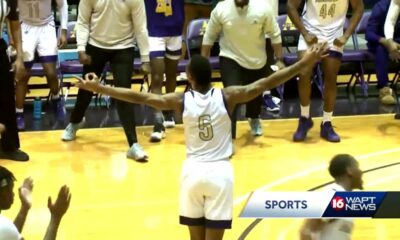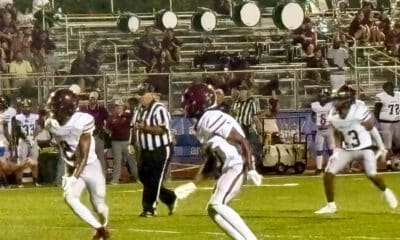Mississippi Today
At 18, Konnor Griffin prepares for biggest day of his life: MLB Draft Day
Put yourself, just for the moment, in Konnor Griffin’ size 13 baseball spikes. Just imagine:
You don’t turn 19 until next April and you just graduated from Jackson Prep. You are the quintessential five-tool professional baseball prospect. That is, you can hit for average and you can hit for power. You can field really well at several positions. You can throw, both from the mound and in the field. And, brother, can you ever run.
Yes, and in four days, your future will change radically. Sunday is Major League Draft Day. You are listed as one of the top 10 professional baseball prospects in the U.S. and the No. 1 high school prospect, period.
You are a shade over 6 feet, 4 inches tall and weigh a streamlined 215 pounds. You have already signed a letter of intent to play college baseball at one of the nation’s top programs, LSU. But your name could be called early in Sunday evening’s draft, and, if so, you will be offered millions and millions of dollars to go somewhere and play the game you love.

The Cleveland Guardians, who have the No. 1 pick and sent a team of eight scouts to watch you back in March, are said to be mightily interested. Most, if not all, Major League teams are. After all, back in February, when Prep was preparing for its first game of the season, 52 professional scouts surrounded the batting cage to watch you hit. Fifty-two. There are only 30 Major League teams. Do the math.
So, tell me. Are you nervous? Are you sleeping well? Are you sleeping at all? I know I wouldn’t be.
Here’s what the real Konnor Griffin, one of the most mature and polite teens you can ever imagine, said earlier this week when asked that question: “I am sleeping just fine. This has been a lot of years in the making and represents a lot of hard work. It’s just a great opportunity I have ahead of me whether it’s to go to LSU or go somewhere and play pro ball. I have no clue, but I am ready to find out. I’m ready to go.”
PODCAST:
That interview was on Monday. On Tuesday, Konnor and his dad, Belhaven softball coach Kevin Griffin, flew to Los Angeles where he will appear on Thursday night’s Espys Awards program on ESPN as the national high school baseball player of the year. On Sunday, he, his family, friends and Jackson Prep teammates and coaches will gather at the Mississippi Sports Hall of Fame Museum for an invitation-only viewing of the MLB Draft.

“It’s out of my hands now. I’ve done what I can do,” Konnor Griffin said. “We’ll see.”
We will. Trying to guess where Konnor Griffin or anyone else will be picked in the baseball draft is a fool’s errand. There are so many factors involved. Major League teams that need more immediate help would be more likely to pick a proven college player, three or four years older and probably more ready for the professional baseball grind. Indeed in recent years, a much higher percentage of early draft picks have been college players rather than kids fresh out of high school. Last year, five of the top seven draft picks and 11 of the top 15 were college players.
There’s the money factor, as well. Much behind-the-scenes negotiation has been — and is — taking place. Major League teams want to know what it will take to sign a player before they draft him. The Griffins are leaving the negotiating to Joey Devine of Excel Sports Management in North Carolina.
LSU’s Paul Skenes, a pitcher, was the first pick last year and signed for $9.2 million. He’s already 5-0 with a 2.12 earned run average for the Pittsburgh Pirates. The first high school player taken was Max Clark of Franklin, Ind. He was the third pick of the draft to the Detroit Tigers and signed for $7.7 million and currently plays for the Tigers Class A team in Lakeland, Fla.
Ask 10 professional scouts and you might get 10 different answers on where Griffin might go in the draft. Ask Mark DeRosa, a former Major League player, former Team USA manager and current MLB Network broadcaster, and you will get this: “The Cleveland Guardians are making a mistake if they don’t pick Konnor Griffin first.”
DeRosa, who has watched Griffin practice and play and spent some time off the field with him, believes Griffin not only as the physical skills, but also the mental make-up to succeed at the Major League level. Not every expert is as sky-high on Griffin as that. The one knock scouts seem to have is the level of competition Griffin has faced in Mississippi high school baseball. That’s a sore point with the Griffins.
“That touches me deep in my heart,” Konnor said. “Our Jackson Prep team could have played with any high school team in the country. We played against really good teams and really good players here. There’s good baseball in Mississippi. Plus, I’ve traveled around the world and played against some of the best players in international competition.”
Said Kevin Griffin, “It’s a tired act when people downplay the quality of baseball in Mississippi. Just look at the players who have come through here and what they’ve gone on to do.”
Let’s do. How about Southaven’s Austin Riley, the two-time All-star third baseman of the Atlanta Braves, who was drafted late in the first round of the 2015 draft? Riley, in 2015, might be the best comparison to Konnor Griffin now. Like Griffin, Riley was a rangy, slender prospect with a frame with plenty room for added muscle. He hit .271 with 20 home runs in his first full season of professional baseball at Class A Rome in 2016. He made his Major League debut three years later. He has hit 146 home runs for the Braves and fields at third base like a reincarnation of Brooks Robinson. He hit 37 home runs last year, 38 the year before. As potentially good as he was in 2015 and as great as he has become, Riley couldn’t run anywhere near like Griffin. It remains to be seen if Griffin will hit with the power Riley has.
“Just to be compared with someone like Austin Riley is like a dream to me,” Griffin said.
Those comparisons began early. Kevin Griffin says the first time it occurred to him his son had special baseball skills was when Konnor was 12. “He hit like 58 home runs that summer,” Kevin Griffin said. “He made plays that you just don’t see 12-year-olds make.”
Konnor’s 12th year on the planet was also the first time Jay Powell, the Mississippi Sports Hall of Famer and former Big League standout, saw him play. “We were in Oxford, and he was playing in a tournament with 12-year-olds,” Powell said. “They played on a high school field with a temporary fence and Konnor hit one not only over temporary fence but also the high school fence in centerfield. It traveled over 370 feet, minimum. That’s when I knew he was special.”
We haven’t even discussed his pitching. Griffin throws in the mid-to-high 90s with devastating slider. He was 10-0 with a 0.72 earned run average and 107 strikeouts in 67 innings.
“He would be a first rounder as a pitcher, even if he didn’t hit and field like he does,” Powell said.
Powell was Major League teammates with such Baseball Hall of Famers as Alex Rodriguez, Chipper Jones and Todd Helton, and says, matter-of-factly, “Konnor Griffin is the best athlete I’ve ever been around.”
For Prep, Griffin hit .559 with nine home runs this spring. He stole 85 bases in 86 attempts. There is seemingly nothing on a baseball field he can’t do, but he says he would prefer to be an everyday player, probably shortstop or centerfielder, rather than pitching full-time.
•••
So we began this column asking readers to put your feet in Konnor Griffin’s shoes. Now then, try on Kevin Griffin’s sneakers.
Your son clearly has all the ability in the world. But he’s still just 18 years young. Next month, he could be on the other side of the continent playing minor league baseball in some small town you and he have never heard of. Are you ready for that? Do you think Konnor is?
“Konnor’s very mature for his age,” Kevin Griffin said. “He’s been a lot of places by himself. He’s had to fend for himself. I don’t have too much of a concern. Now my wife Kim would probably tell you something different. I don’t think she’s looking forward to the possibility of him being across the country, by himself, in some minor league town. But we’ve trusted the process. We feel like he’s mature enough to go out and spread his wings. We’re in a good place.”
The Griffins are just excited – and more a little nervous – to see what happens next. Put yourself in their shoes. Wouldn’t you be?
This article first appeared on Mississippi Today and is republished here under a Creative Commons license.
Mississippi Today
A Mississippi town moves a Confederate monument that became a shrouded eyesore
GRENADA (AP) — A Mississippi town has taken down a Confederate monument that stood on the courthouse square since 1910 — a figure that was tightly wrapped in tarps the past four years, symbolizing the community’s enduring division over how to commemorate the past.
Grenada’s first Black mayor in two decades seems determined to follow through on the city’s plans to relocate the monument to other public land. A concrete slab has already been poured behind a fire station about 3.5 miles (5.6 kilometers) from the square.
But a new fight might be developing. A Republican lawmaker from another part of Mississippi wrote to Grenada officials saying she believes the city is violating a state law that restricts the relocation of war memorials or monuments.
The Grenada City Council voted to move the monument in 2020, weeks after police killed George Floyd in Minneapolis. The vote seemed timely: Mississippi legislators had just retired the last state flag in the U.S. that prominently featured the Confederate battle emblem.
The tarps went up soon after the vote, shrouding the Confederate soldier and the pedestal he stood on. But even as people complained about the eyesore, the move was delayed by tight budgets, state bureaucracy or political foot-dragging. Explanations vary, depending on who’s asked.
A new mayor and city council took office in May, prepared to take action. On Sept. 11, with little advance notice, police blocked traffic and a work crew disassembled and removed the 20-foot (6.1-meter) stone structure.
“I’m glad to see it move to a different location,” said Robin Whitfield, an artist with a studio just off Grenada’s historic square. “This represents that something has changed.”
Still, Whitfield, who is white, said she wishes Grenada leaders had invited the community to engage in dialogue about the symbol, to bridge the gap between those who think moving it is erasing history and those who see it as a daily reminder of white supremacy. She was among the few people watching as a crane lifted parts of the monument onto a flatbed truck.
“No one ever talked about it, other than yelling on Facebook,” Whitfield said.
Mayor Charles Latham said the monument has been “quite a divisive figure” in the town of 12,300, where about 57% of residents are Black and 40% are white.
“I understand people had family and stuff to fight and die in that war, and they should be proud of their family,” Latham said. “But you’ve got to understand that there were those who were oppressed by this, by the Confederate flag on there. There’s been a lot of hate and violence perpetrated against people of color, under the color of that flag.”
The city received permission from the Mississippi Department of Archives and History to move the Confederate monument, as required. But Rep. Stacey Hobgood-Wilkes of Picayune said the fire station site is inappropriate.
“We are prepared to pursue such avenues that may be necessary to ensure that the statue is relocated to a more suitable and appropriate location,” she wrote, suggesting a Confederate cemetery closer to the courthouse square as an alternative. She said the Ladies Cemetery Association is willing to deed a parcel to the city to make it happen.
The Confederate monument in Grenada is one of hundreds in the South, most of which were dedicated during the early 20th century when groups such as the United Daughters of the Confederacy sought to shape the historical narrative by valorizing the Lost Cause mythology of the Civil War.
The monuments, many of them outside courthouses, came under fresh scrutiny after an avowed white supremacist who had posed with Confederate flags in photos posted online killed nine Black people inside the historic Emanuel African Methodist Episcopal Church in Charleston, South Carolina, in 2015.
Grenada’s monument includes images of Confederate president Jefferson Davis and a Confederate battle flag. It was engraved with praise for “the noble men who marched neath the flag of the Stars and Bars” and “the noble women of the South,” who “gave their loved ones to our country to conquer or to die for truth and right.”
A half-century after it was dedicated, the monument’s symbolism figured in a voting rights march. When the Rev. Martin Luther King Jr. and other civil rights leaders held a mass rally in downtown Grenada in June 1966, Robert Green of the Southern Christian Leadership Conference scrambled up the pedestal and planted a U.S. flag above the image of Davis.
The cemetery is a spot Latham himself had previously advocated as a new site for the monument, but he said it’s too late to change now, after the city already budgeted $60,000 for the move.
“So, who’s going to pay the city back for the $30,000 we’ve already expended to relocate this?” he said. “You should’ve showed up a year and a half ago, two years ago, before the city gets to this point.”
A few other Confederate monuments in Mississippi have been relocated. In July 2020, a Confederate soldier statue was moved from a prominent spot at the University of Mississippi to a Civil War cemetery in a secluded part of the Oxford campus. In May 2021, a Confederate monument featuring three soldiers was moved from outside the Lowndes County Courthouse in Columbus to another cemetery with Confederate soldiers.
Lori Chavis, a Grenada City Council member, said that since the monument was covered by tarps, “it’s caused nothing but more divide in our city.”
She said she supports relocating the monument but worries about a lawsuit. She acknowledged that people probably didn’t know until recently exactly where it would reappear.
“It’s tucked back in the woods, and it’s not visible from even pulling behind the fire station,” Chavis said. “And I think that’s what got some of the citizens upset.”
This article first appeared on Mississippi Today and is republished here under a Creative Commons license.
Crooked Letter Sports Podcast
Podcast: New Orleans sports columnist and author Jeff Duncan joins the podcast to talk about his new Steve Gleason book and the new-look New Orleans Saints.
Jeff Duncan went from the Mississippi Book Festival in Jackson on Saturday to Jerry World in Dallas on Sunday where he watched and wrote about the Saints’ total dismantling of the Dallas Cowboys. We talk about both events and also about what happened in high school and college football last weekend and what’s coming up this weekend.
Stream all episodes here.
This article first appeared on Mississippi Today and is republished here under a Creative Commons license.
Mississippi Today
On this day in 1899
Sept. 18, 1899

Scott Joplin, known as “the King of Ragtime,” copyrighted the “Maple Leaf Rag,” which became the first song to sell more than 1 million copies of sheet music. The popularity launched a sensation surrounding ragtime, which has been called America’s “first classical music.”
Born near Texarkana, Texas, Joplin grew up in a musical family. He worked on the railroad with other family members until he was able to earn money as a musician, traveling across the South. He wound up playing at the World’s Fair in Chicago in 1893, where he met fellow musician Otis Saunders, who encouraged him to write down the songs he had been making up to entertain audiences. In all, Joplin wrote dozens of ragtime songs.
After some success, he moved to New York City, hoping he could make a living while stretching the boundaries of music. He wrote a ragtime ballet and two operas, but success in these new forms eluded him. He was buried in a pauper’s grave in New York City in 1917.
More than six decades later, his music was rediscovered, initially by Joshua Rifkin, who recorded Joplin’s songs on a record, and then Gunther Schuller of the New England Conservatory, who performed four of the ragtime songs in concert: “My faculty, many of whom had never even heard of Joplin, were saying things like, ‘My gosh, he writes melodies like Schubert!’”
Joplin’s music won over even more admirers through the 1973 movie, “The Sting,” which won an Oscar for the music. His song, “The Entertainer,” reached No. 3 on Billboard and was ranked No. 10 among “Songs of the Century” list by the Recording Industry Association of America. His opera “Treemonisha” was produced to wide acclaim, and he won a Pulitzer Prize in 1976 for his special contribution to American music.
“The ragtime craze, the faddish thing, will obviously die down, but Joplin will have his position secure in American music history,” Rifkin said. “He is a treasurable composer.”
This article first appeared on Mississippi Today and is republished here under a Creative Commons license.
-
Mississippi News Video5 days ago
Woman arrested after reposting school threat in Calhoun County
-
News from the South - Louisiana News Feed6 days ago
Food drive underway for Hurricane Francine victims in Kenner
-
Mississippi Today3 days ago
On this day in 1925
-
News from the South - Kentucky News Feed5 days ago
The search for Joseph Couch intensifies
-
News from the South - Alabama News Feed2 days ago
Diddy Arrested In Manhattan | September 16, 2024 | News 19 at 10 p.m.
-
News from the South - Alabama News Feed5 days ago
Sylacauga Church welcomes Haitian migrants amid speculations
-
Mississippi Today3 days ago
Another Midwest drought is causing transportation headaches on the Mississippi River
-
News from the South - Florida News Feed6 days ago
Tropics update: Tropical Depression 7, 2 other disturbances brewing in Atlantic









































